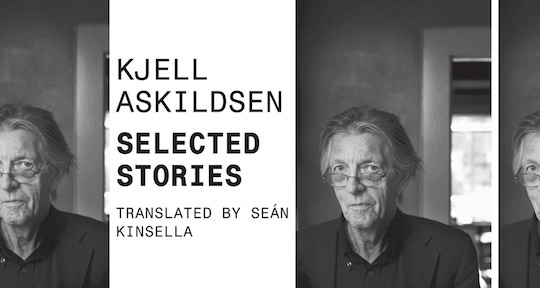A man. A woman. Intimacy. Distance. These are the elements, according to Norwegian writers Bjarte Breiteig and Øyvind Ellenes, writing in the literary magazine Vinduet, that make up a Kjell Askildsen story. And indeed, in Selected Stories, a collection of 11 of Kjell Askildsen’s stories translated by Seán Kinsella from Dalkey Archive Press, characters who approach each other yet are repelled by each other and by themselves are the thread running through the work. The four elements are like the last few impossible letters you are stuck with at the end of a Scrabble game. You can arrange and rearrange them and study the board, and while they will combine in umpteen ways, they will never resolve into one word you can lay out, cleanly.
Askildsen, at 84, is one of the grand old men of Norwegian literature. Frequently mentioned alongside other greats like Jon Fosse and Tor Ulven—also to be published by Dalkey Archive in its series of translated Norwegian modern writing—Askildsen’s first story collection From now on I’ll follow you all the way home was published in 1953. The last stories in the book are from the collection The dogs of Thessaloniki, published in 1996.
Yet a reader never has the sense that any time has passed between the writing of these stories. They take place, seemingly, in the same timeless void. The things which surround people are timeless, too: coffee, beer, funerals, injuries, and erotic desire. Language is unadorned, and this adds to the eternal flavor: if these stories appeared in a lineup, you wouldn’t be able to pick the 1960s stories out among a crowd of newer ones.
Seán Kinsella’s translation appears faithful to the original language, so unadorned and repetitive. This is a world in which characters only and ever “say”; they never murmur or croon or shout or whisper or state or assert. Things just are what they are. Norwegian is a fairly small language, with only around 60,000 words. English, by some estimates, has three times as many. The limited, uninflected way Askildsen writes therefore isn’t as notable a style choice in Norwegian as it is in English. Anglophones are likely to find his work notably minimalist—bare and spare. And while these characteristics really are Askildsen in Norwegian too, they’re not as extreme in the original. The translation therefore carries a strain of a nearly aseptic, technical, machine-like steely tone that the original doesn’t really to my mind have. No, what many Norwegian critics note about Askildsen is his empathy for his characters, which has developed over his decades as a storyteller.
The stories in this collection often take place during the brief, stifling Arctic summers of Norway, when the buttoned-up populace loosens its garments and drunkenly speaks a few words of truth for a change. Reading about people relating to each other in such a bare, naked manner is emotionally exhausting.
“Martin Hansen’s Outing” is the first story of the collection, and coincidentally Askildsen’s last published story, from 1999. A man spies on his young daughter and her friend, lies to his wife, gets drunk and injured, then suddenly tells his wife a truth. What does it change? Nothing. In the second story, “The Dogs of Thessaloniki,” a man and his companion try to talk to each other over coffee, wine, and cigarettes, and speak to each other of dogs they once saw mating in Thessaloniki, who couldn’t get free. The story ends with the man breaking a cane he used to lean on, while his companion sleeps on her side of the bed. In the story “A great deserted landscape,” the also classic Askildsen feature of uncomfortable, incestuous sexuality enters the story. A severely injured man is being cared for by his sister, while his wife is being laid to rest.
I asked her to fetch my sunglasses, I didn’t want her to misunderstand. She went to find them. It was only the two of us; the others were at the funeral service. She came back and put the sunglasses on me. I formed a kiss with my lips. She smiled. I thought: if she only knew. The sunglasses were so dark that I could look at her body without her noticing.
This is an Askildsen character: injured enough to be stuck inside himself, helpless to deny the dark impulses he also contains. Askildsen is, then, in Norwegian literature known as a pessimist. His work describes a certain kind of Everyman, a limited person, who nevertheless is a normal, everyday character in this society. The Norwegian literary critic Henning Hagerup in the afterword to the Norwegian edition of Askildsen’s “Collected Stories” claims to really have seen Askildsen types hanging around town.
If you go to places like Cafe Norrøna or Kaffistova here in Oslo, you will all the time run into figures who could have been taken out of an Askildsen novella: Old, tired, fairly penniless women and men who neverthelesss are well-dressed and who are scarfing down a cheap dinner of casserole or boiled cod as they maintain conversations about anything other than the acknowledged Great Topics.
Askildsen’s world is paradoxically both limited and limitless. Only a few things happen to his characters, everything out of ordinary life and nothing externally very dramatic. Yet within themselves, the characters are everything: they are infinitely good and bad, often at the same time; they have great tenderness for each other and are unspeakably cruel to each other too. They’re the world in a grain of sand.
***
Kjell Askildsen’s Selected Stories, translated by Seán Kinsella, is available from Dalkey Archive Press.
***
Julia Grønnevet is a freelancer journalist and Asymptote’s editor-at-large for Norway.

